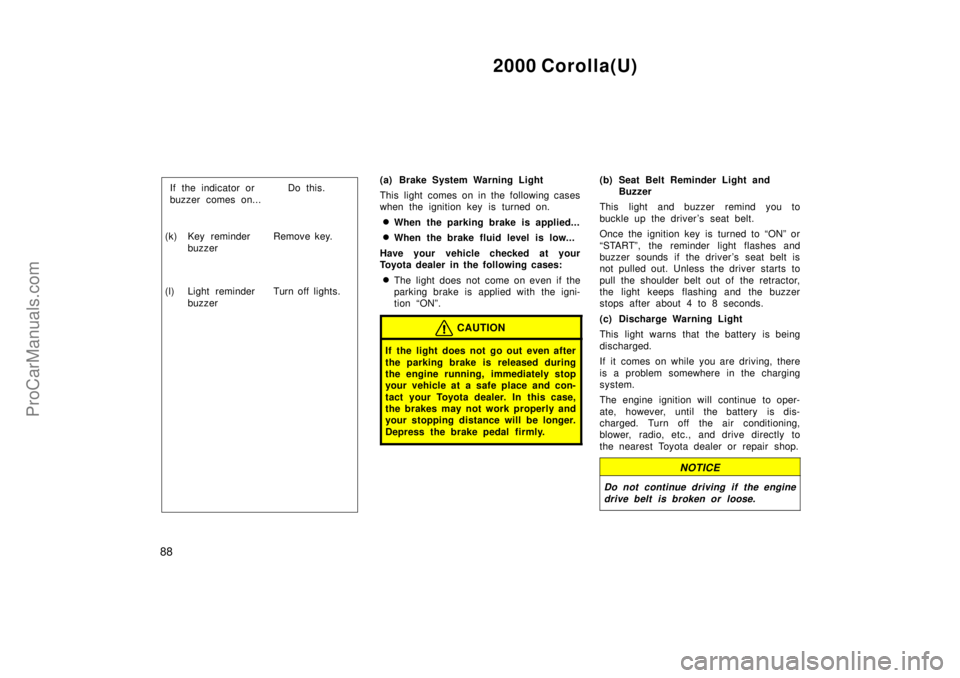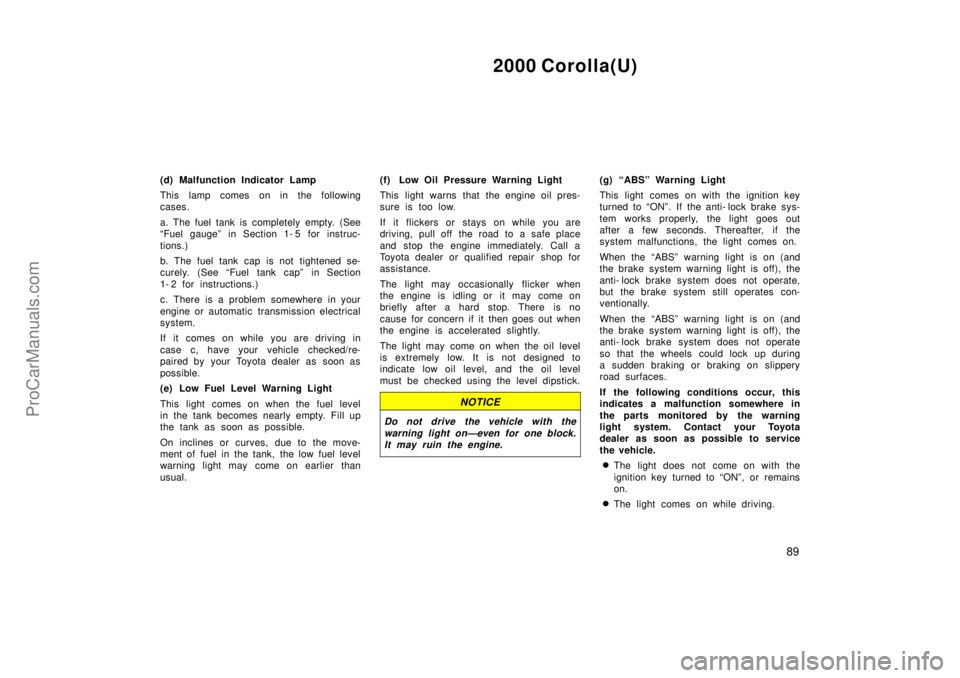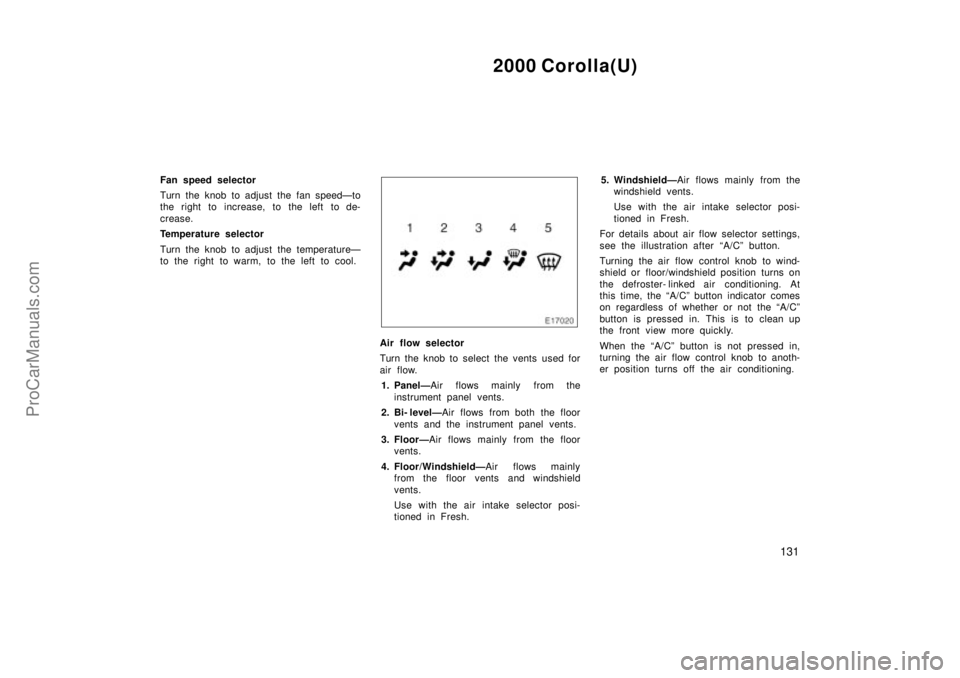Page 162 of 246

2000 Corolla(U)
88
(k) Remove key.Key reminder
buzzer
(l) Turn off lights.Light reminder
buzzer If the indicator or
buzzer comes on...Do this.(a) Brake System Warning Light
This light comes on in the following cases
when the ignition key is turned on.
�When the parking brake is applied...
�When the brake fluid level is low...
Have your vehicle checked at your
Toyota dealer in the following cases:
�The light does not come on even if the
parking brake is applied with the igni-
tion ONº.
CAUTION
If the light does not go out even after
the parking brake is released during
the engine running, immediately stop
your vehicle at a safe place and con-
tact your Toyota dealer. In this case,
the brakes may not work properly and
your stopping distance will be longer.
Depress the brake pedal firmly.
(b) Seat Belt Reminder Light and
Buzzer
This light and buzzer remind you to
buckle up the driver's seat belt.
Once the ignition key is turned to ONº or
STARTº, the reminder light flashes and
buzzer sounds if the driver 's seat belt is
not pulled out. Unless the driver starts to
pull the shoulder belt out of the retractor,
the light keeps flashing and the buzzer
stops after about 4 to 8 seconds.
(c) Discharge Warning Light
This light warns that the battery is being
discharged.
If it comes on while you are driving, there
is a problem somewhere in the charging
system.
The engine ignition will continue to oper-
ate, however, until the battery is dis-
charged. Turn off the air conditioning,
blower, radio, etc., and drive directly to
the nearest Toyota dealer or repair shop.
NOTICE
Do not continue driving if the engine
drive belt is broken or loose.
ProCarManuals.com
Page 163 of 246

2000 Corolla(U)
89
(d) Malfunction Indicator Lamp
This lamp comes on in the following
cases.
a. The fuel tank is completely empty. (See
Fuel gaugeº in Section 1- 5 for instruc-
tions.)
b. The fuel tank cap is not tightened se-
curely. (See Fuel tank capº in Section
1- 2 for instructions.)
c. There is a problem somewhere in your
engine or automatic transmission electrical
system.
If it comes on while you are driving in
case c, have your vehicle checked/re-
paired by your Toyota dealer as soon as
possible.
(e) Low Fuel Level Warning Light
This light comes on when the fuel level
in the tank becomes nearly empty. Fill up
the tank as soon as possible.
On inclines or curves, due to the move-
ment of fuel in the tank, the low fuel level
warning light may come on earlier than
usual.(f) Low Oil Pressure Warning Light
This light warns that the engine oil pres-
sure is too low.
If it flickers or stays on while you are
driving, pull off the road to a safe place
and stop the engine immediately. Call a
Toyota dealer or qualified repair shop for
assistance.
The light may occasionally flicker when
the engine is idling or it may come on
briefly after a hard stop. There is no
cause for concern if it then goes out when
the engine is accelerated slightly.
The light may come on when the oil level
is extremely low. It is not designed to
indicate low oil level, and the oil level
must be checked using the level dipstick.
NOTICE
Do not drive the vehicle with the
warning light onÐeven for one block.
It may ruin the engine.
(g) ABSº Warning Light
This light comes on with the ignition key
turned to ONº. If the anti- lock brake sys-
tem works properly, the light goes out
after a few seconds. Thereafter, if the
system malfunctions, the light comes on.
When the ABSº warning light is on (and
the brake system warning light is off), the
anti- lock brake system does not operate,
but the brake system still operates con-
ventionally.
When the ABSº warning light is on (and
the brake system warning light is off), the
anti- lock brake system does not operate
so that the wheels could lock up during
a sudden braking or braking on slippery
road surfaces.
If the following conditions occur, this
indicates a malfunction somewhere in
the parts monitored by the warning
light system. Contact your Toyota
dealer as soon as possible to service
the vehicle.
�The light does not come on with the
ignition key turned to ONº, or remains
on.
�The light comes on while driving.
ProCarManuals.com
Page 164 of 246

2000 Corolla(U)
90
If the light lit during driving goes out and
does not come on again, it is a normal
operation.
(h) Open Door Warning Light
This light remains on until all the doors
are completely closed.
(i) SRS Warning Light
This light will come on when the igni-
tion key is turned to the ACCº or
ONº position. After about 6 seconds,
the light will go off. This means the
system of the airbag and front seat belt
pretensioners are operating properly.
The warning light system monitors the air-
bag sensor assemblies, front airbag sen-
sors, seat belt pretensioner assemblies,
inflators, warning light, interconnecting wir-
ing and power sources.
If either of the following conditions occurs,
this indicates a malfunction somewhere in
the parts monitored by the warning light
system. Contact your Toyota dealer as
soon as possible to service the vehicle.
�The light does not come on when the
ignition key is turned to the ACCº or
ONº position or remains on.
�The light comes on or flashes while
driving.(j) Low Windshield Washer Fluid Level
Warning Light
The light warns that the windshield washer
fluid level is too low. Add washer fluid at
your earliest opportunity. (For instructions,
see Adding washer fluidº in Section 7- 3.)
(k) Key Reminder Buzzer
This buzzer reminds you to remove the
key when you open the driver 's door with
the ignition key in the ACCº or LOCKº
position.
(l) Light Reminder Buzzer
This buzzer will sound if the head light
switch is left on and the driver's door is
opened with the key removed from the
ignition switch.CHECKING SERVICE REMINDER INDICA-
TORS (except the low fuel level warning
light and low windshield washer fluid
level warning light)
1. Apply the parking brake.
2. Open one of the doors.
The open door warning light should
come on.
3. Close the door.
The open door warning light should go
off.
4. Turn the ignition key to ACCº.
The SRS warning light should come on.
It goes off after about 6 seconds.
5. Turn the ignition key to ONº, but do
not start the engine.
All the service reminder indicators ex-
cept the open door warning light and
SRS warning light should come on. The
ABSº warning light goes off after a
few seconds.
If any service reminder indicator or warn-
ing buzzer does not function as described
above, either the bulb is burned out or the
circuit is in need of repair. Have it
checked by your Toyota dealer as soon as
possible.
ProCarManuals.com
Page 200 of 246
2000 Corolla(U)
126
CARING FOR YOUR COMPACT DISC
PLAYER AND DISCS
�Use only compact discs labeled as
shown.
�Extremely high temperatures can keep
your compact disc player from working.
On hot days, use the air conditioning
to cool the vehicle interior before you
listen to a disc.
�Bumpy roads or other vibrations may
make your compact disc player skip.
�If moisture gets into your compact disc
player, you may not hear any sound
even though your compact disc player
appears to be working. Remove the
disc from the player and wait until it
dries.
ProCarManuals.com
Page 203 of 246
2000 Corolla(U)
129
OPERATION OF INSTRUMENTS AND
CONTROLS
Air conditioning system
Controls130 . . . . . . . . . . . . . . . . . . . . . . . . . . . . . . . . . . . . . . . . . . . . . . . . . . .
Air flow selector settings133 . . . . . . . . . . . . . . . . . . . . . . . . . . . . . . . . . . . . .
Operating tips133 . . . . . . . . . . . . . . . . . . . . . . . . . . . . . . . . . . . . . . . . . . . . . .
Side vents135 . . . . . . . . . . . . . . . . . . . . . . . . . . . . . . . . . . . . . . . . . . . . . . . . .
SECTION 1- 8
ProCarManuals.com
Page 205 of 246

2000 Corolla(U)
131
Fan speed selector
Turn the knob to adjust the fan speedÐto
the right to increase, to the left to de-
crease.
Temperature selector
Turn the knob to adjust the temperatureÐ
to the right to warm, to the left to cool.
Air flow selector
Turn the knob to select the vents used for
air flow.
1. PanelÐAir flows mainly from the
instrument panel vents.
2. Bi- levelÐAir flows from both the floor
vents and the instrument panel vents.
3. FloorÐAir flows mainly from the floor
vents.
4. Floor/WindshieldÐAir flows mainly
from the floor vents and windshield
vents.
Use with the air intake selector posi-
tioned in Fresh.5. WindshieldÐAir flows mainly from the
windshield vents.
Use with the air intake selector posi-
tioned in Fresh.
For details about air flow selector settings,
see the illustration after A/Cº button.
Turning the air flow control knob to wind-
shield or floor/windshield position turns on
the defroster- linked air conditioning. At
this time, the A/Cº button indicator comes
on regardless of whether or not the A/Cº
button is pressed in. This is to clean up
the front view more quickly.
When the A/Cº button is not pressed in,
turning the air flow control knob to anoth-
er position turns off the air conditioning.
ProCarManuals.com
Page 206 of 246
2000 Corolla(U)
132
Air intake selector
Move the lever to select the air source.
1. RecirculateÐRecirculates the air inside
the vehicle.
2. FreshÐDraws outside air into the sys-
tem.A/Cº button
To turn on the air conditioning, press the
A/Cº button. The A/Cº button indicator
will come on. To turn the air conditioning
off, press the button again.
If the A/Cº button indicator flashes, there
is a problem in the air conditioning system
and the air conditioning automatically
shuts off. If this happens, take your ve-
hicle to a Toyota dealer for service.
ProCarManuals.com
Page 207 of 246
2000 Corolla(U)
133
Air flow selector settings Operating tips
�To cool off your Toyota after it has
been parked in the hot sun, drive with
the windows open for a few minutes.
This vents the hot air, allowing the air
conditioning to cool the interior more
quickly.
�Make sure the air intake grilles in front
of the windshield are not blocked (by
leaves or snow, for example).
�On humid days, do not blow cold air
on the windshield. The windshield could
fog up because of the difference in air
temperature on the inside and outside
of the windshield.
�Keep the area under the front seats
clear to allow air to circulate through-
out the vehicle.
�On cold days, move the fan speed to
HIº for a minute to help clear the in-
take ducts of snow or moisture. This
can reduce the amount of fogging on
the windows.
ProCarManuals.com